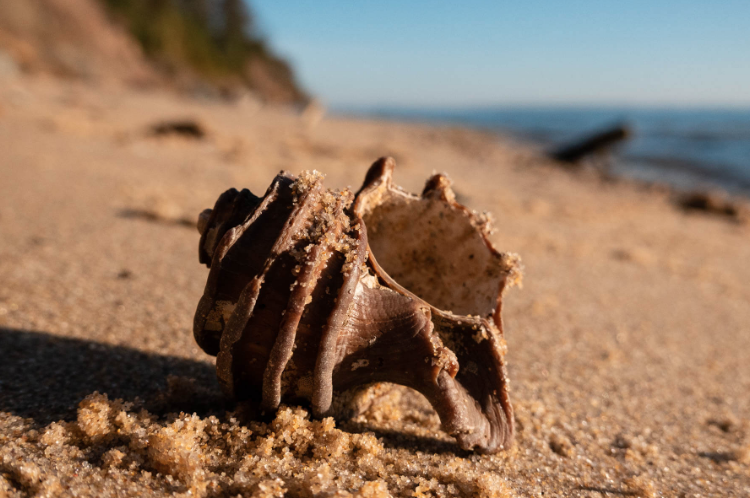This article was originally published at the Chesapeake Bay Program website by Jake Solyst on January 26th, 2021. Thank you to Jake for letting us share this article on our blog!
——————————————————————————————————————
Most Marylanders can tell you about the local blue crab or diamondback terrapin but few can identify the state fossil: an extinct, several-million-year-old snail known as the Ecphora gardnerae gardnerae (Wilson).
In 1770, the Ecphora became one of the first fossils from the “New World” to be illustrated in a scientific work in Europe, labeled by naturalists as “a marilandia” meaning “from Maryland.” Flash forward two-and-a-half centuries and the Natural History Society of Maryland is keeping the fossil’s legacy intact. On an early morning in January, 10 members of the organization’s Fossil Club convened at Driftwood Beach, a private property along Calvert Cliffs where the conditions are ripe for finding the coveted shell.
“On this particular beach, you get better preservation of these Ecphora shells than most other places,” said Victor Perez, assistant curator of paleontology at Calvert Marine Museum. According to Perez, the shells tend to be fragile while they are still in the clay, but if they dry out naturally they are more likely to remain intact. Driftwood Beach also has a less rocky shoreline than other beaches along the Calvert Cliffs, so the shells are broken up by the waves less often.
Unless you have an expert eye, the multiple species of Ecphora can look the same, but are no less exciting of a find. The fossil has a unique orange to maroon coloring, which has to do with an organic molecule in the shell that preserves the color. As a predatory snail, it would bore holes through the shell of other mollusks, usually bivalves, eating the creature and leaving a perfectly round hole you might use to thread a necklace.
The fossils on Driftwood Beach are from Miocene age, which dates between 23 to 5 million years ago. There are three geologic formations of Miocene age exposed in Calvert Cliffs: St. Marys Formation, Choptank Formation and Calvert Formation. Because the layers of sediment on the cliffs are inclined slightly to the south, the exposed beds get progressively younger from north to south, with the Calvert Formation being the oldest and St. Marys being the youngest. Driftwood Beach is on the southern end of Calvert Cliffs, making the fossils found in that location of the St. Marys Formation, estimated to be between 10 to 7-and-a-half-million years old.
As the tide comes in and erodes the cliff walls, the several-million-year-old fossils are exposed and either remain plastered to the wall or get raked into a sinuous path of shells on the beach.
“The water doesn’t know what’s a fossil and what isn’t,” said Perez. “It just accumulates everything on the shore.”
Searching either the wall or the shoreline is a suggested strategy for fossil hunters—though it is illegal, and dangerous, to dig directly out of the cliff face.

In addition to accessing beaches with ideal geological conditions, Fossil Club members get exposure to local experts. Along with Perez, who was a visiting guest from the museum, was trip leader Nick Spero, a board member of the Natural History Society of Maryland and a master forager. Spero and Perez help members navigate the beach and identify their finds. On that day in January, not all members were in search of Ecphora; shark teeth, fossilized burrows left in the cliff walls or anything else peeking members’ curiosity was on the table.
“The organizers of this club, they are the most welcoming, generous leaders of any club I’ve ever participated in,” said Marla, a member who happened to find the largest Ecphora of the day. “It’s their enthusiasm, they want to share it with everyone else.”
Perez is a strong advocate for amateur paleontology, especially people who are collecting because they love to do it and enjoy the thrill of finding things.
“Our science relies on that,” said Perez. “If you go to a museum collection, most of the fossils in those museums are going to be collected by amateur paleontologists.”
The Natural History Society of Maryland has three other clubs in addition to the fossil club: Herpetology (reptiles and amphibians), Lepidoptera (butterflies and moths), and Archaeology. The group’s mission is to foster stewardship of Maryland’s natural heritage by conserving its natural history collections, educating its citizenry and inspiring its youth to pursue careers in the natural sciences.
Walking along the beach with Spero and Tom Dembeck, another active member of the Natural History Society of Maryland and fossil club member, I could see how personally invested they all were in that vision.
“The great thing about this organization is that we’re really friendly to all groups of people,” said Spero. “If beginners come out, the more experienced people will give them advice, show them what they found.”
“A lot of what we do is try to pass this on to the younger generation,” added Tom, walking a few feet from Spero with his waders in the water.
“That’s huge,” agreed Spero. He paused for a beat, eyes on the sand as the gentle waves lapped in. “The appreciation I have with the natural world is a big part of my life. And I like to pass that on.”
——————————————————————————————————————

About Jake Solyst – As a web content specialist at the Chesapeake Bay Program, Jake writes, edits and manages content for the Chesapeake Bay Program’s flagship website while overseeing the partnership’s social media strategy. He has several years of content production experience and is currently enrolled in a Professional Writing M.S. program at Towson University. A Maryland-native, Jake was born in a suburb of Annapolis and now lives a dog-walk away from the waterfront in Canton, Baltimore.

